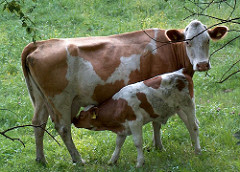A new PLoS One article from Dorado-GarcÃa et al. on the effectiveness of certain countermeasures to antimicrobial resistance shows some encouraging results. The study used MRSA levels as a positive indicator for antimicrobial resistance in Dutch veal farms. There were three methods of reducing MRSA levels in the farms that were studied: one program used protocol-driven methods, one used protocol and cleaning/disinfection methods, and the final did neither (this was the control). Surprisingly, the authors found that while the protocol methods showed reduced MRSA levels, the protocol plus cleaning and disinfection methods were no different from the control. The caveat, as pointed out in the abstract, is that MRSA levels were already low at the start of the experiment for the protocol only farms. However, a change in MRSA levels was still observed after applying the different methods. It is also important to note that the authors tested farmers, family members, and veal for MRSA since these are all potential vectors for transferring antimicrobial resistance.

The topic of antimicrobial resistance in farming and food production is covered in a number of other microBEnet posts as well:
Resistance film showing at UC Davis